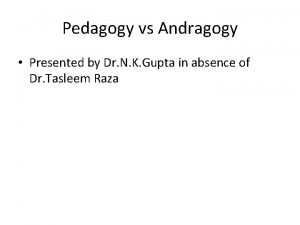FACULTY OF EDUCATION Department of Curriculum and Pedagogy















- Slides: 15

FACULTY OF EDUCATION Department of Curriculum and Pedagogy Physics Vector Components Science and Mathematics Education Research Group Supported by UBC Teaching and Learning Enhancement Fund 2012 -2013

Vector Components Question Title y 3 m/s ? x 4 m/s In this question set, any bolded variable is considered a vector.

Vector Addition Question Title with Ph. ET http: //phet. colorado. edu/en/simulation/vector-addition

Vector Components I Question Title A. 3 m/s B. 4 m/s A ball is travelling with velocity v. The x-component of the velocity is 4 m/s, and the y-component is 3 m/s. What is the magnitude of the velocity of the ball? y C. 5 m/s D. 7 m/s 3 m/s 4 m/s x

Solution Comments Answer: C, 5 m/s Justification: Answers A and B are the magnitudes of the individual components of the resultant vector. When adding vectors, to determine the magnitude of the resulting vector, you cannot just add the magnitudes of the two vectors. The magnitude of a vector can be found by applying Pythagoras’ theorem to its components. v 2 = (4 m/s)2 + (3 m/s)2 v 2 = 16 m 2/s 2 + 9 m 2/s 2 v = 5 m/s

Vector Components II Question Title A. 12° B. 28° A ball is travelling 4 m/s in the x direction and 3 m/s in the y direction. At what angle is the ball moving above the x-axis? y C. 37° D. 53° 3 m/s ? 4 m/s x

Solution Comments Answer: C, 37° Justification: The tangent of the angle between the vector and the x -axis is equal to the ratio of the y component to the x component. From Pythagorean theorem, vx= 4 m/s, vy = 3 m/s, v= 5 m/s. We have three alternative solutions that give the same answer:

Vector Components III Question Title A. 2. 8 m/s B. 5 m/s A ball is travelling with velocity v. The x-component of the velocity is 4 m/s and the y-component is 4 m/s. What is the magnitude of the velocity of the ball? y C. 5. 7 m/s D. 8 m/s 4 m/s ? 4 m/s x

Solution Comments Answer: C, 5. 7 m/s Justification: The vector components form a right angle triangle. Pythagorean Theorem can be applied to obtain the length of the resultant vector. v 2 =(4 m/s)2 + (4 m/s)2 v 2 = 32 m 2/s 2 v = 5. 7 m/s

Vector Components IV Question Title A. 15° B. 30° A ball is travelling 4 m/s in the x direction and 4 m/s in the y direction. At what angle is the ball moving above the x-axis? y C. 45° D. 60° 4 m/s ? 4 m/s x

Solution Comments Answer: C Justification: The vector components form an isosceles, right angle triangle. In an isosceles triangle, the angles across from the equal sides are also equal. The angles in a triangle must always add up to 180°. y B 180° = 90° + A + B 180° = 90° + 2 A 90° = 2 A 4 m/s 45° = A x A ? 4 m/s C

Vector Components V Question Title A. 45° B. 135° A ball is travelling 4 m/s in the -x direction and 4 m/s in the y direction. At what angle is the ball moving relative to the positive side of the x-axis? C. 225° D. 315° 4 m/s ? 4 m/s

Solution Comments Answer: B Justification: Similar to the previous question, the vector components form a right angle isosceles triangle. This means that the angles between the vector and the negative x-axis and positive y-axis are both 45°. Because we are looking for the angle between the vector and the positive x-axis, we need to consider the distance between the positive y-axis and positive x-axis, which is 90°. Adding the two angles together gives 135°. If the vector were in the third quadrant, the answer would be 225°, and if the vector were in the fourth quadrant the answer would be 315°.

Vector Components VI Comments A ball is travelling with the velocity v. What are the x- and y- components of the velocity vector? y θ x

Solution Comments Answer: C Justification: In this scenario, vx is the vector adjacent to the angle and vy is the vector opposite to the angle. sin θ = opposite/hypotenuse cos θ = adjacent/hypotenuse tan θ = opposite/adjacent Since tan θ involves both vy and vx, it will give us no information about the individual components. sin θ = vx /v, rearrange to solve for vx = vsinθ cos θ = vy/v, and rearranging this gives vy = vcosθ
 Education scotland play pedagogy toolkit
Education scotland play pedagogy toolkit Gauteng department of education strategic plan 2020
Gauteng department of education strategic plan 2020 Nit calicut chemistry faculty
Nit calicut chemistry faculty Ga tapp program
Ga tapp program Sport pedagogy definition
Sport pedagogy definition Advanced pedagogy and application of ict book pdf
Advanced pedagogy and application of ict book pdf Epistemology and pedagogy
Epistemology and pedagogy Importance of faculty in higher education
Importance of faculty in higher education Myfile yorku
Myfile yorku Faculty of education
Faculty of education Chronicle of higher education faculty salaries
Chronicle of higher education faculty salaries Faculty of education khon kaen university
Faculty of education khon kaen university Techno pedagogy
Techno pedagogy Public pedagogy definition
Public pedagogy definition Pedagogy vs androgogy
Pedagogy vs androgogy Pedagogy literally means
Pedagogy literally means





























